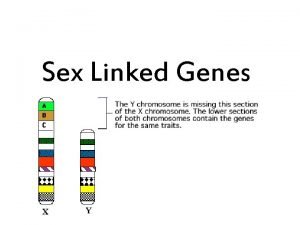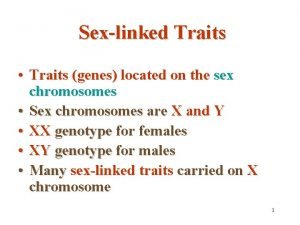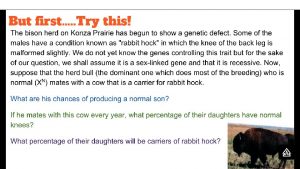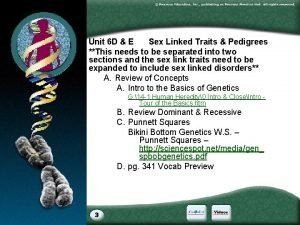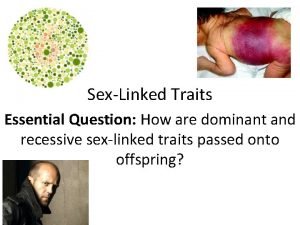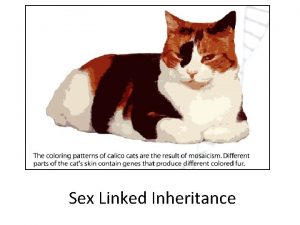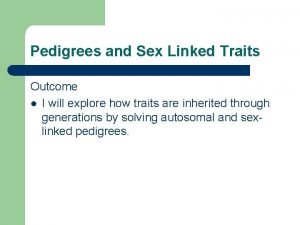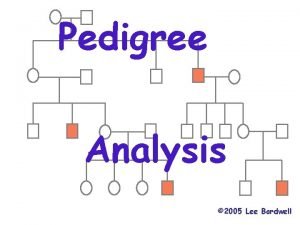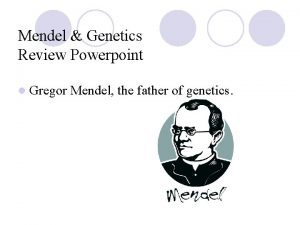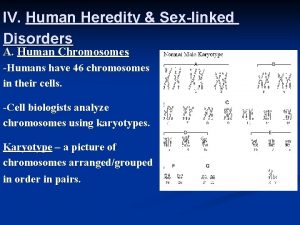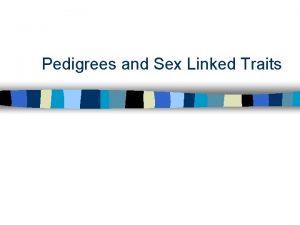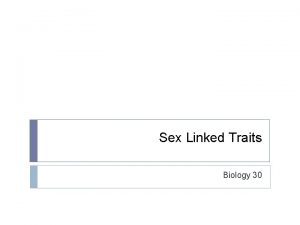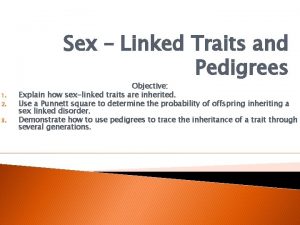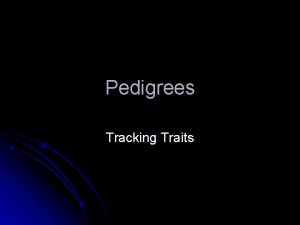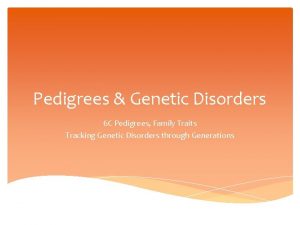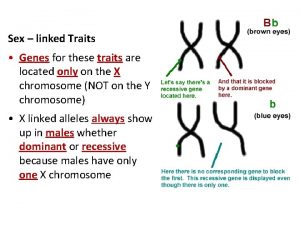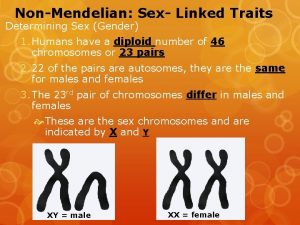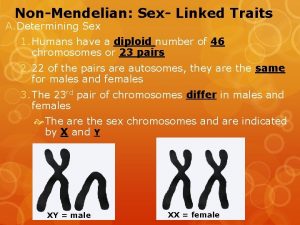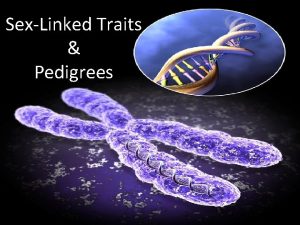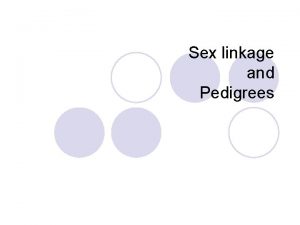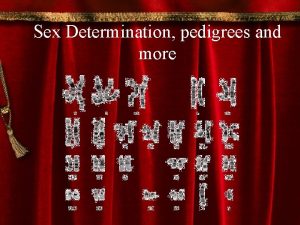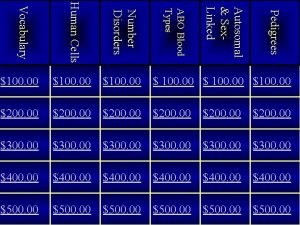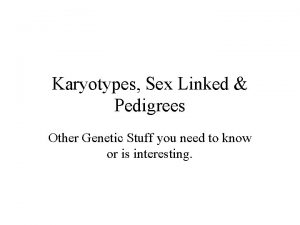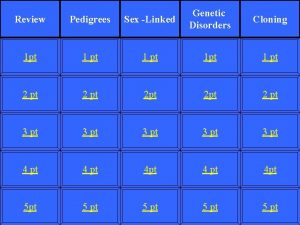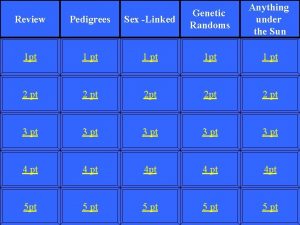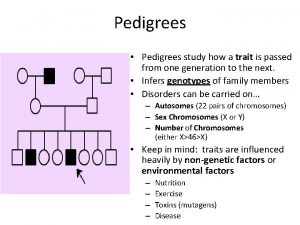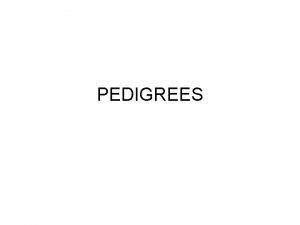Unit 6 D E Sex Linked Traits Pedigrees























- Slides: 23

Unit 6 D & E Sex Linked Traits & Pedigrees **This needs to be separated into two sections and the sex link traits need to be expanded to include sex linked disorders** A. Review of Concepts A. Intro to the Basics of Genetics G: 14 -1 Human Heredity� Intro & CloseIntro - Tour of the Basics. htm B. Review Dominant & Recessive C. Punnett Squares Bikini Bottom Genetics W. S. – Punnett Squares – http: //sciencespot. net/media/gen_ spbobgenetics. pdf D. pg. 341 Vocab Preview Go to Section:

Human Chromosomes What do you think that sex chromosomes are? Sex Chromosomes are the two chromosomes that determine an organism’s sex. They also code for a few other characteristics. – The two sex chromosomes can be either an X or a Y. – The X codes for female, while the Y codes for male. Autosomes are all of the other chromosomes – all the chromosomes a that are not the sex chromosomes. In humans there 23 homologous pairs of chromosomes, totaling 46 chromosomes: 2 sex chromosomes 44 autosomes Go to Section:

Checkpoint Questions 1. What is a karyotype? 2. What are the sex chromosomes? 3. Which sex chromosomes do female have? 4. Which sex chromosomes do males have? 5. How many chromosomes are in the human genome? 6. How many autosomes are in the human genome? 7. How many sex chromosomes are in the human genome? 8. How many pairs of chromosomes are in the human genome? 9. What are the chances of having a boy? 10. Draw a Punnett Square representing the gametes of a cross between a male and a female. Go to Section:

Interest Grabber Section 14 -1 A Family Tree To understand how traits are passed on from generation to generation, a pedigree, or a diagram that shows the relationships within a family, is used. In a pedigree, a circle represents a female, and a square represents a male. A filled-in circle or square shows that the individual has the trait being studied. The horizontal line that connects a circle and a square represents a marriage. The vertical line(s) and brackets below that line show the child(ren) of that couple. Go to Section:

Interest Grabber continued Section 14 -1 1. This pedigree shows the inheritance of attached ear lobes. Which parent has attached ear lobes? 2. How many children do the parents have? Which child has attached ear lobes? 3. Which child is married? Does this child’s spouse have attached ear lobes? Do any of this child’s children have attached ear lobes? Go to Section:

Figure 14 -3 A Pedigree Section 14 -1 A circle represents a female. A horizontal line connecting a male and female represents a marriage. A half-shaded circle or square indicates that a person is a carrier of the trait. A completely shaded circle or square indicates that a person expresses the trait. Go to Section: A square represents a male. A vertical line and a bracket connect the parents to their children. A circle or square that is not shaded indicates that a person neither expresses the trait nor is a carrier of the trait.

Go to Section: Reading the Pedigree

The pedigree below is for a genetic disease or abnormality. We do not yet know if it is dominant or recessive. We will determine if it is possible that the trait is autosomal dominant. If the trait were dominant, we would use the following designations: A = the trait (a genetic disease or abnormality, dominant) a = normal (recessive) If the trait were recessive, we would use the following designations: A = normal (dominant) a = the trait (a genetic disease or abnormality, recessive) Go to Section:

The pedigree shows that three of the individuals have the recessive (normal) phenotype and one individual has the dominant (abnormal) phenotype. 1. Write the genotype of the affected (abnormal) individual next to her symbol in the pedigree below. If you only know one of the genes (letters), use a "? " for the unknown letter. 2. Is it possible that the pedigree above is for an autosomal dominant trait? 3. Write the genotypes next to the symbol for each person in the pedigree below assuming that it is for a dominant trait.

Is it possible that this pedigree is for an autosomal dominant trait? Go to Section:

2. We will determine if the pedigree below can be for a trait that is autosomal dominant. Use "A" and "a" as you did for the pedigrees above. a) Write the genotype of each individual next to the symbol. b) Is it possible that this pedigree is for an autosomal dominant trait? c) In conclusion, can two individuals that have an autosomal dominant trait have unaffected children? Go to Section:

a) Assuming that the trait is recessive, write the genotype of each individual next to the symbol. b) Is it possible that the pedigree above is for an autosomal recessive trait? c) Assuming that the pedigree below is for a recessive trait, write the genotype next to the symbol for each person. Go to Section:

d) Is it possible that this pedigree is for an autosomal recessive trait? Go to Section:

4. We will determine if the pedigree below can be for a trait that is autosomal recessive. Use "A" and "a" as you did for the previous example. a) Write the genotype of each individual next to the symbol. b) Is it possible that this pedigree is for an autosomal recessive trait? c) If a trait is autosomal recessive, what can you conclude about the children of two parents that are not affected? Put your answer to this question in the summary table (item #4) in the answer sheet. Go to Section:

We will determine if the pedigree below can be for a trait that is autosomal recessive. a) Write the genotype of each individual next to the symbol. b) Is it possible that this pedigree is for an autosomal recessive trait? c) In this pedigree, two generations have been skipped. What can you conclude about recessive traits skipping generations? Put your answer to this question in the summary table (item #5) in the answer sheet.

X-Linked Recessive The conclusions that you made for autosomal recessive traits apply to X-linked traits. In this exercise, we will work on some additional conclusions because males have only one X chromosome and females have two. 6. We will determine if the pedigrees below can be for a trait that is X-linked recessive. Use the following designations: XA = normal Xa = the trait (a genetic disease or abnormality) Y = Y chromosome (males only) Go to Section:

a) Write the genotype of each individual next to the symbol. b) Is it possible that the pedigree above is for an X-linked recessive trait? c) Write the genotype next to the symbol for each person in the pedigree below. d) Is it possible that this pedigree is for an X-linked recessive trait?

e) Write the genotype next to the symbol for each person in the pedigree below. f) Is it possible that this pedigree is for an X-linked recessive trait? g) Write the genotype next to the symbol for each person in the pedigree below. h) Is it possible that this pedigree is for an X-linked recessive trait?

a) Write the genotype of each individual next to the symbol. b) Is it possible that this pedigree is for an X-linked recessive trait? c) Which parent did the son get the Xa gene from? d) What can you conclude about father-to-son transmission of X-linked traits? Go to Section:

a) Write the genotype of each individual next to the symbol. b) Is it possible that this pedigree is for an X-linked recessive trait? c) What can you conclude about the children if both parents are affected with an X-linked recessive trait? d) How does this conclusion compare with the one you made earlier if about both parents being affected by an autosomal recessive trait? e) Do the conclusions that you made for autosomal recessive traits apply to X-linked recessive traits? Go to Section:

9 a. If a genetic disease is X-linked recessive, what is the phenotype of a female that has only one disease allele (Xa)? b. What is the phenotype of a male with one disease allele? c. What can you conclude about the number of males that would have the disease compared to the number of females? Go to Section:

Pedigree for the Albino Trait Pedigree for a Sex Linked Trait

Concept Questions 1. 2. 3. 4. 5. 6. 7. What is a pedigree? What is recessive? What is dominant? What is hetrozygous? What is homozygous? What is meant by X-linked? What could be the genotype of a person with an autosomal recessive disorder? 8. What could be the genotype of someone who didn’t display any characteristics of an autosomal recessive disorder? 9. What could be the genotype of the son of a man who had and X-linked disorder? 10. A man has an X-linked disorder. His wife does not. Will is daughter have it? 11. A woman has an X-linked disorder. Her husband does not have it. Will their daughter have it? Go to Section:
 Kurt bumby
Kurt bumby Snv sex
Snv sex Xxtesticles
Xxtesticles Sex sex sex
Sex sex sex Sex sex sex
Sex sex sex Sex-linked punnett square
Sex-linked punnett square What are sex linked genes
What are sex linked genes Sex linkage example
Sex linkage example Punnett square blood type ab and o
Punnett square blood type ab and o Outsider rules pedigree
Outsider rules pedigree Sex linked trait
Sex linked trait Advantage of linked list
Advantage of linked list Difference between an array and a linked list
Difference between an array and a linked list Fungsi linked list
Fungsi linked list Whats sex linked
Whats sex linked Sex linked pedigree
Sex linked pedigree Sexlinked traits
Sexlinked traits Whats a sex linked trait
Whats a sex linked trait Is methemoglobinemia autosomal or sexlinked
Is methemoglobinemia autosomal or sexlinked Example of x linked recessive
Example of x linked recessive Autosomal vs sex linked
Autosomal vs sex linked Autosomal vs sex linked
Autosomal vs sex linked Double crossing over
Double crossing over Sex linked disorders
Sex linked disorders






